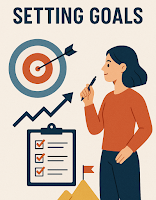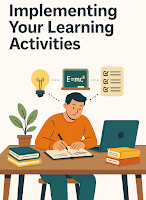Skills Learned
Learning to Learn

JavaScript

Reduce Stress




At the end of November 2020, I created a professional development plan for the upcoming year using Malcolm Knowles’ (1975) Six-Step Self-Directed Learning Model. My aim was twofold: to lead by example and to bring more structure and intentionality to my professional growth.
The first step in the model is to identify learning needs. At the time, three key priorities emerged:
Encourage my team to take greater ownership of their professional development.
Learn to manage stress more effectively.
Improve my JavaScript skills to match the level I had achieved in C# and Swift.

| Focus | People | Tasks |
|---|---|---|
| Abstract | Learn to Learn | Category Theory & Lambda Calculus |
| Concrete | Reducing Stress & Refocusing the Mind | JavaScript & Knockout |
| Diagnose Needs | Formulate Goals | Identify Resources |
|---|---|---|
| Learning Strategies | Learn to Learn | Professional Development Course Learn to Learn Course |
| Wellbeing |
Reducing Stress & Refocusing the Mind |
sleep - 8hrs exercise - 30min meditation - 5min play music - 15min |
| Happiness & Wellbeing | The Science of Well Being Course | |
| JavaScript & Frameworks | Generic JavaScript | Advanced JavaScript courses MDN Coursera courses JS for web devs JS, jQuery, JSON web programming |
| KnockoutJS | https://knockoutjs.com/ | |
| Functional Programming | Category Theory | Category Theory for Programmers Book |
| Lambda Calculus |



 Work
WorkI started a new job in March 2020 and a few weeks into the new job everyone was transitioning to working from home. I was a little hesitant at first as the schools had closed and my apartment was full of noisy children. However the children were good about being quiet while I was running meetings. My team adjusted to video meetings and we were soon communicating far more frequently than when we were sharing an office. The company was committed to making remote work effective therefore the transition was well planned and the IT infrastructure put in place to support remote work.
We all adapted surprisingly quickly and everyone made allowances for the situation, if there were people passing in the background of a video or a bit of extra noise it was no big deal.
Biggest requirement is to draw boundaries. When I first started working remotely I thought the problem would be that my personal life would bleed into my work life, however my family is good about not disturbing me while I am at work. A bigger problem is my work life bleeding into my personal life. There is always the temptation to do one more thing. Also there are time zone differences so even when you're off work other members of the team are still working, and in this always connected world, there is the temptation to respond to queries. I have seen team members respond while they are on vacation or after hours or on the weekend and I must admit that I have done the same.
It is sometimes difficult to balance your needs with other people's needs. One of the attendees of my meetings asked to shift the time so that she could pick up her child from school. I was happy to ask the other attendees if they were okay with the new time then adjust the time. I had faced the exact same problem the previous month, but had made other arrangements rather than inconvenience my co-workers. I realize now that I should have done as she had and asked my attendees if they were okay with a new time. It is important to ask for what you need to succeed and thrive.
I am back to working one day a week in the city. I prefer remote work and most of my co-workers feel the same. The company has gone from having a dedicated office to renting a co-working space. This also means they have gone from having dedicated on-premises servers to having everything in the cloud.
Unfortunately the transition back has not been as well organized as the transition to remote. At the start of COVID there was a sense of urgency and a determination to get things right. Whereas with the transition first to partial on site work and then to a co-working space the attitude has been more laissez-faire.
My employer is not the only business to shift to co-working spaces and cities all over the world are dealing with a shift in tenancy patterns.
 Family
Family You would think that being cooped up in the same apartment we would see a lot more of each other, but we actually see less of each other now. Part of it is that the girls are getting older and more independent, but part of it is lifestyle changes brought by COVID. We now have more than twice the number of devices in the apartment than we did before COVID. It used to be that the family would sit in front of the TV sharing a movie, but those days are long gone. Now the TV is only used for news and video games. The demise of the idiot box isn't exactly a tragedy, some would call it a boon. However everyone stays in their room, working on their devices or video calling their friends or watching media. Sometimes the only thing that breaks the illusion that I am alone in the apartment is when one of my daughters comes out of her room and asks me for help with her school work.
Thank the stars for card games. We played cards before COVID, I taught the girls when they were very young, and it has always been a fun shared activity but card games became a lot more important after COVID. We still go walking around the park when the park is open and restrictions allow, but less frequently than we did. We also used to do a lot of improv games. Those have gotten a little less popular as the girls get older but are still fun.
We have to schedule time together now and make family time a priority, where before it just happened.
 Exercise
Exercise With the gym and pool shut down in the middle of the crisis I was reduced to running up and down the stairs. Thankfully things are back open again, but I still haven't fully gotten back into my old routine.
The girls had it worse with almost everything shut down. They are back doing most of their activities such as swimming lessons, gymnastics and dancing. However they still do less activities than they did before. I worry about the effect of spending so much time indoors has had on them.
Hard skills (task-based) and soft skills (people-based) are both critical. Almost every job requires you to both:
Complete tasks independently, and
Collaborate effectively with others.
The best development plans include a mix of both.
| Skills Type |
Description | Examples |
|---|---|---|
| Concrete | Practical, task-specific, and easy to test | A programming language, a framework, using Excel formulas |
| Semi-abstract | Broader patterns or principles across contexts | Design Patterns, SOLID principles |
| Abstract | General problem-solving or conceptual tools | Divergent/convergent thinking, TRIZ, Systems Thinking |
Your development plan should evolve with your career. Don’t just train for what you do today—train for what you want to become tomorrow. Balance is key: concrete and abstract, strengths and weaknesses, task and people skills. The most resilient professionals are those who invest in both depth and breadth—and who never stop learning.
